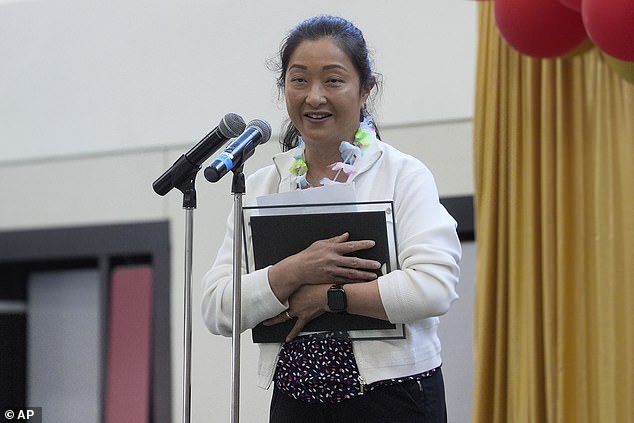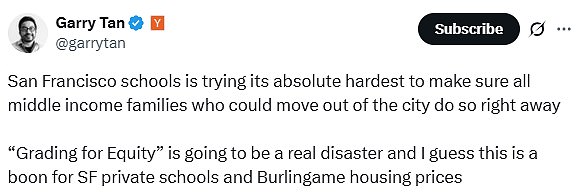Today, San Francisco’s top educator faced an embarrassing reversal of their stance on a particular issue.
woke
a new initiative to decrease passing thresholds in order to foster ‘fairness.’
School Superintendent Maria Su introduced the new ‘Grading for Equity’ initiative recently, which proposes eliminating homework and weekly assessments. Under this plan, students could potentially pass with a score as low as 41, compared to the present passing threshold of 61.
However, mere hours later on Wednesday afternoon, Su issued a statement amid broad criticism from all sides of politics, indicating that the district would postpone enforcing the measure for one year.
She stated: “During the May 27 School Board meeting, we introduced a plan for a professional development session focused on standards-based grading. However, no decisions were made during this gathering. The district as well as the School Board has not implemented any modifications to current grading procedures.”
We set high expectations for all SFUSD students and aim to foster their success by emphasizing learning and proficiency. Clearly, numerous queries, worries, and misconceptions surround this proposal.
We aim to guarantee that any modifications will be advantageous for our students. I have opted against pursuing this approach for the upcoming year to allow us sufficient time to genuinely involve the community.
‘At present, we must keep concentrating on maintaining our budget balance, steadying the district, and restoring confidence.’
Ro Khanna, a Democratic representative from Silicon Valley who advocates for progressive principles, criticized the action on X with this comment: “My immigrant father questioned me about the missing 10% when I got a score of 90. He moved to America seeking the opportunity to hustle and strive for greatness.”


‘Achieving an A grade with only 80% effort and eliminating homework does not equate to fairness; it undermines the American Dream and disregards each parent’s aspirations for their children’s success.’
According to
The Voice of San Francisco
, the plan was scheduled to be implemented later this autumn.
The report stated that under the proposed plan, homework and weekly tests would no longer contribute significantly to a student’s final semester grade.
A pupil’s score would depend exclusively on their end-of-term test, which they have the option to retake several times.
Students might submit assignments tardily or skip classes altogether without this impacting their final grades.
The current standards require students to achieve a score of 90 for an A grade and maintain a minimum of 61 for a D grade.
The modifications imply that a score as low as 80 will now qualify for an A grade, whereas a mark of 21 will result in a D grade.
Democratic venture capitalist Garry Tan sharply criticized the action. He stated, “The San Francisco school system is doing everything possible to ensure that all middle-income families who might leave the city will do so as quickly as they can.”



‘”Grading for Equity” is likely to create significant problems, which may inadvertently benefit San Francisco’s private schools and drive up property values in Burlingame.’
‘For education administrators who undermine our public schools with unjust and non-meritorious policies: BUSINESS IS THRIVING.’
‘An investigation into the Schools of Education responsible for these policies must be conducted as they pose a significant threat to public schools across the board.’
Entrepreneur Chamath Palihapitiya commented: “On the surface, this is completely absurd. It’s also shameful that such an issue arises from what should be the leading technology hub globally.”
‘Nonetheless, this will significantly benefit property values in regions near SF.’
As reported by the source, the region reached out to Joe Feldman for his expertise, as he was instrumental in introducing a comparable framework in Placer County back in 2019.
In a 2019 piece published by the School Superintendents Association, Feldman stated: “The number of students getting D’s and F’s dropped—this decline was even steeper among students of color and those with special needs.”
The increase in grades, as indicated by the rising number of A’s awarded, has slowed down, with a sharper decline observed particularly within the more advantaged student groups.
The accuracy of students’ grades increased rather than merely improving. Better grading methods notably narrowed the gap between students’ grades and their performance on standardised tests covering the same material. This improvement was particularly pronounced and frequent among students eligible for free or reduced-cost lunches.
‘Both students and educators noted more relaxed classroom environments and improved connections between teachers and pupils.’
The Voice mentioned that the new system would follow a model used in the San Leandro Unified School District.
In that particular school district, students can obtain an A grade with a score of 80 percent and pass with a D at 21 percent.
Read more







